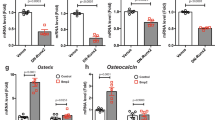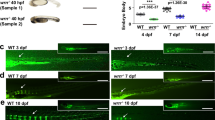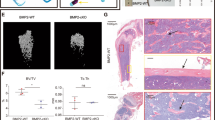Abstract
Core-binding factor β (CBFβ, also called polyomavirus enhancer binding protein 2β (PEBP2B)) is associated with an inversion of chromosome 16 and is associated with acute myeloid leukemia in humans1. CBFβ forms a heterodimer with RUNX1 (runt-related transcription factor 1), which has a DNA binding domain homologous to the pair-rule protein runt in Drosophila melanogaster. Both RUNX1 and CBFβ are essential for hematopoiesis2,3,4,5,6. Haploinsufficiency of another runt-related protein, RUNX2 (also called CBFA1), causes cleidocranial dysplasia in humans7 and is essential in skeletal development by regulating osteoblast differentiation and chondrocyte maturation8,9,10,11,12,13,14,15. Mice deficient in Cbfb (Cbfb−/−) die at midgestation4,5,6, so the function of Cbfβ in skeletal development has yet to be ascertained. To investigate this issue, we rescued hematopoiesis of Cbfb−/− mice by introducing Cbfb using the Gata1 promoter. The rescued Cbfb−/− mice recapitulated fetal liver hematopoiesis in erythroid and megakaryocytic lineages and survived until birth, but showed severely delayed bone formation. Although mesenchymal cells differentiated into immature osteoblasts, intramembranous bones were poorly formed. The maturation of chondrocytes into hypertrophic cells was markedly delayed, and no endochondral bones were formed. Electrophoretic mobility shift assays and reporter assays showed that Cbfβ was necessary for the efficient DNA binding of Runx2 and for Runx2-dependent transcriptional activation. These findings indicate that Cbfβ is required for the function of Runx2 in skeletal development.
This is a preview of subscription content, access via your institution
Access options
Subscribe to this journal
Receive 12 print issues and online access
$209.00 per year
only $17.42 per issue
Buy this article
- Purchase on Springer Link
- Instant access to full article PDF
Prices may be subject to local taxes which are calculated during checkout






Similar content being viewed by others
References
Liu, P. et al. Fusion between transcription factor CBFβ/PEBP2β and a myosin heavy chain in acute myeloid leukemia. Science 261, 1041–1044 (1993).
Okuda, T., Deursen, J., van Hiebert, S.W., Grosveld, G. & Downing, J.R. AML1, the target of multiple chromosomal translocation in human leukemia, is essential for normal fetal liver hematopoiesis. Cell 84, 321–330 (1996).
Wang, Q. et al. Disruption of the Cbfa2 gene causes necrosis and hemorrhaging in the central nervous system and blocks definitive hematopoiesis. Proc. Natl Acad. Sci. USA 93, 3444–3449 (1996).
Sasaki, K. et al. Absence of fetal liver hematopoiesis in mice deficient in transcriptional coactivator core binding factor β. Proc. Natl Acad. Sci. USA 93, 12359–12363 (1996).
Wang, Q. et al. The CBFβ subunit is essential for CBFα2 (AML1) function in vivo. Cell 87, 697–708 (1996).
Niki, M. et al. Hematopoiesis in the fetal liver is impaired by targeted mutagenesis of a gene encoding a non-DNA binding subunit of the transcription factor, polyomavirus enhancer binding protein 2/core binding factor. Proc. Natl Acad. Sci. USA 94, 5697–5702 (1997).
Mundlos, S. et al. Mutations involving the transcription factor CBFA1 cause cleidocranial dysplasia. Cell 89, 773–779 (1997).
Komori, T. et al. Targeted disruption of Cbfa1 results in a complete lack of bone formation owing to maturational arrest of osteoblasts. Cell 89, 755–764 (1997).
Otto, F. et al. Cbfa1, a candidate gene for cleidocranial dysplasia syndrome, is essential for osteoblast differentiation and bone development. Cell 89, 765–771 (1997).
Ducy, P., Zhang, R., Geoffroy, V., Ridall, A.L. & Karsenty, G. Osf2/Cbfa1: a transcriptional activator of osteoblast differentiation. Cell 89, 747–754 (1997).
Inada, M. et al. Maturational disturbance of chondrocytes in Cbfa1-deficient mice. Dev. Dyn. 214, 279–290 (1999).
Kim, I.S., Otto, F., Zabel, B. & Mundlos, S. Regulation of chondrocyte differentiation by Cbfa1. Mech. Dev. 80, 159–170 (1999).
Enomoto, H. et al. Cbfa1 is a positive regulatory factor in chondrocyte maturation. J. Biol. Chem. 275, 8695–8702 (2000).
Ueta, C. et al. Skeletal malformations caused by overexpression of Cbfa1 or its dominant negative form in chondrocytes. J. Cell. Biol 153, 87–99 (2001).
Takeda, S., Bonnamy, J.P., Owen, M.J., Ducy, P. & Karsenty, G. Continuous expression of Cbfa1 in non-hypertrophic chondrocytes uncovers its ability to induce hypertrophic chondrocyte differentiation and partially rescues Cbfa1-deficient mice. Genes Dev. 15, 467–481 (2001).
Onodera, K. et al. GATA-1 transcription is controlled by distinct regulatory mechanisms during primitive and definitive erythropoiesis. Proc. Natl Acad. Sci. USA 94, 4487–4492 (1997).
Takakura, N. et al. A role for hematopoietic stem cells in promoting angiogenesis. Cell 102, 199–209 (2000).
Tahirov, T.H. et al. Structural analyses of DNA recognition by the AML1/Runx-1 Runt domain and its allosteric control by CBFβ. Cell 104, 755–767 (2001).
Thirunavukkarasu, K., Mahajan, M., Mclarren, K.W., Stifani, S. & Karsenty, G. Two domains unique to osteoblast-specific transcription factor Osf2/Cbfa1 contribute to its transactivation function and its inability to heterodimerize with Cbfβ. Mol. Cell. Biol. 18, 4197–4208 (1998).
Huang, G. et al. Dimerization with PEBP2β protects RUNX1/AML1 from ubiquitin-proteasome-mediated degradation. EMBO J. 20, 723–733 (2001).
Ducy, P. et al. A Cbfa1-dependent genetic pathway controls bone formation beyond embryonic development. Genes Dev. 13, 1025–1036 (1999).
Drissi, H. et al. Transcriptional autoregulation of the bone related CBFA1/RUNX2 gene. J. Cell. Physiol. 184, 341–350 (2000).
Miller, J. et al. The core-binding factor β subunit is required for bone formation and hematopoietic maturation. Nature Genet. 32, 645–649 (2002).
Kundu, M. et al. Cbfβ interacts with Runx2 and has a critical role in bone development. Nature Genet. 32, 639–644 (2002).
Lee, K.S. et al. Runx2 is a common target of transforming growth factor β1 and bone morphogenetic protein 2, and cooperation between Runx2 and Smad5 induces osteoblast-specific gene expression in the pluripotent mesenchymal precursor cell line C2C12. Mol. Cell. Biol. 20, 8783–8792 (2000).
Chiba, N. et al. Differentiation-dependent expression and distinct subcellular localization of the protooncogene product, PEBP2β/CBFβ, in muscle development. Oncogene 14, 2543–2552 (1997).
Deguchi, K. et al. Excessive extramedullary hematopoiesis in Cbfa1-deficient mice with a congenital lack of bone marrow. Biochem. Biophys. Res. Commun. 255, 352–359 (1999).
Onishi, M. et al. Applications of retrovirus-mediated expression cloning. Exp. Hematol. 24, 324–329 (1996).
Morita, S., Kojima, T. & Kitamura, T. Plat-E: an efficient and stable system for transient packaging of retroviruses. Gene Ther. 7, 1063–1066 (2000).
Harada, H. et al. Cbfa1 isoforms exert functional differences in osteoblast differentiation. J. Biol. Chem. 274, 6972–6978 (1999).
Herz, J. & Gerard, R.D. Adenovirus-mediated transfer of low density lipoprotein receptor gene acutely accelerates cholesterol clearance in normal mice. Proc. Natl Acad. Sci. USA 90, 2812–2816 (1993).
Lu, J. et al. Subcellular localization of the α and β subunits of the acute myeloid leukemia-linked transcription factor PEBP2/CBF. Mol. Cell. Biol. 3, 1651–1661 (1995).
Acknowledgements
We thank M. Yamamoto for the Gata1 promoter; Y. Ito for antibodies against Runx2 and Cbfβ; T. Kitamura for retroviral vector and Platinum-E; H. Harada for Runx2 and Cbfb cDNA; Y. Fujio for pACCMV.pLpA vector; A. Yamaguchi and M. Iwamoto for critically reading this manuscript; K. Sasaki, S. Bae and H. Enomoto for technical advice; R. Hiraiwa for maintaining mouse colonies; and M. Yanagita for secretarial assistance. This work was supported by grants from the Japanese Ministry of Education, Culture, Sports, Science and Technology.
Author information
Authors and Affiliations
Corresponding author
Ethics declarations
Competing interests
The authors declare no competing financial interests.
Rights and permissions
About this article
Cite this article
Yoshida, C., Furuichi, T., Fujita, T. et al. Core-binding factor β interacts with Runx2 and is required for skeletal development. Nat Genet 32, 633–638 (2002). https://doi.org/10.1038/ng1015
Received:
Accepted:
Published:
Issue Date:
DOI: https://doi.org/10.1038/ng1015
This article is cited by
-
Osteoblast-derived vesicles induce a switch from bone-formation to bone-resorption in vivo
Nature Communications (2022)
-
Identification of a familial cleidocranial dysplasia with a novel RUNX2 mutation and establishment of patient-derived induced pluripotent stem cells
Odontology (2022)
-
The Association Between Runx Signaling and Craniofacial Development and Disease
Current Osteoporosis Reports (2022)
-
The relationship between abnormal Core binding factor-β expression in human cartilage and osteoarthritis
BMC Musculoskeletal Disorders (2021)
-
MicroRNA treatment modulates osteogenic differentiation potential of mesenchymal stem cells derived from human chorion and placenta
Scientific Reports (2021)



